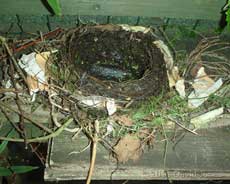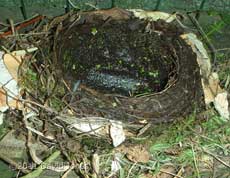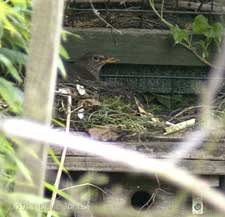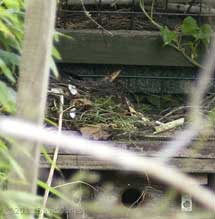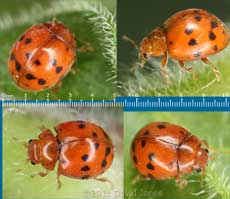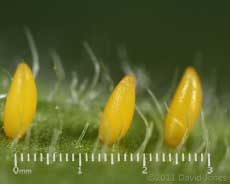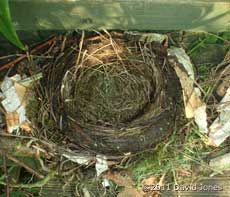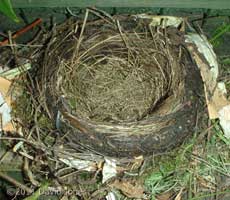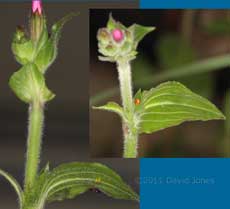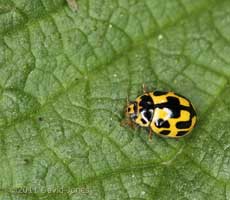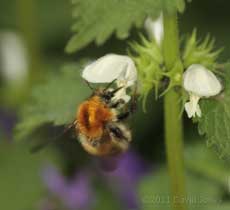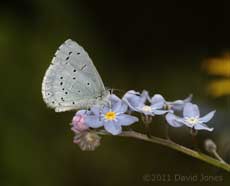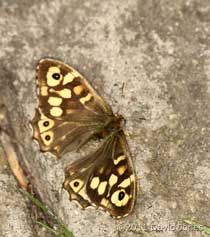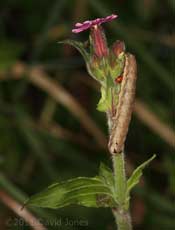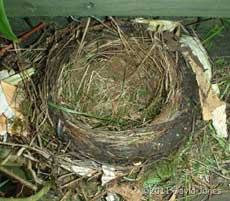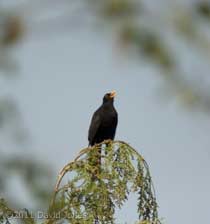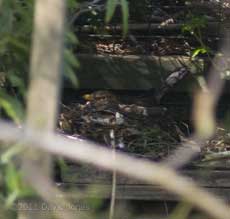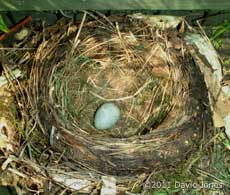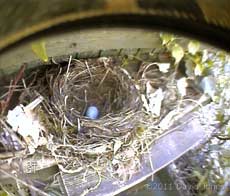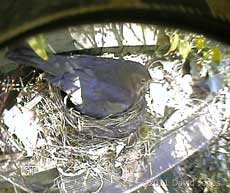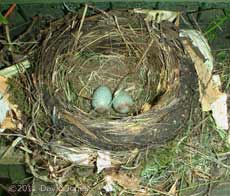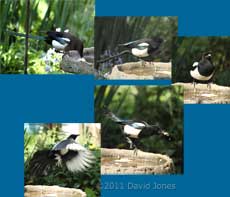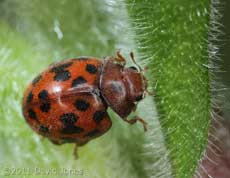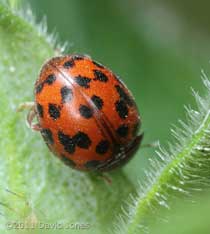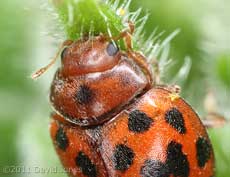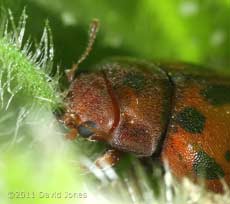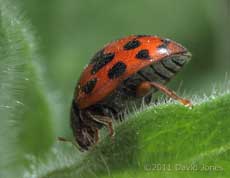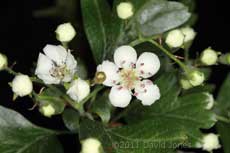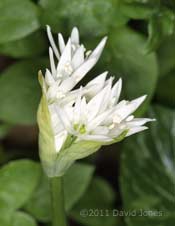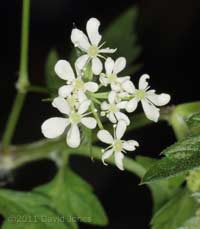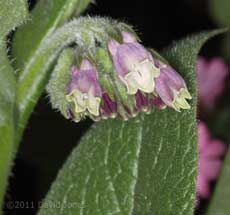Go to the last entry on this page .....Go to previous entry16 April - As we head into the second half of April the dry weather has continued. Grey skies this morning gave way to a short sunny spell in the early afternoon which helped to boost the temperature to over 17C before dropping by a couple of degrees as thick cloud moved in from the south-west. By the time I was drinking a 'wake-up' cup of tea by 7am the female Blackbird was already working on her nest, a task she continued with throughout the day, apart from numerous breaks. It would have been nice to have recorded details of her activities but it wasn't possible today.
By 4pm when this picture was taken during one of her periods away from the nest it was clear to see just how much progress had been made today. Last thing yesterday evening there was little more than a small amount of straw and some pieces of birch bark.
After starting off the day using 'dry' materials like straw, birch bark, moss and grass she then turned to the big pond for the wet plant matter to build the nest cup itself - you can even see the bright green of duckweed. Clearly there is more to be done - the shiny bottom to the nest is actually the roofing felt covering of the nest box lid.
Family visits meant that I didn't get a chance today to set up a cctv camera, although I have now got the camera and lens ready, and I hope to create a housing for it tomorrow.
In the meantime I can see part of the nest from the dining room window, and here is the female soon after 4pm (horrible lighting conditions thanks to the cloud cover!). The post to the left of the picture is rather annoying, but I have a length of rope ready to pull it a bit to the left when she takes another break.
The sounds of her shuffles have been with us all day as the nest cup was being fashioned, and as she does this work she presses her body down into the cup, her beak (and tail) pointing steeply upwards. She pushes herself against the sides of the cup so that the shape of the cup sides mirrors the profile of the front of her body as she repeats the process over and over again, each time facing in a different direction.
During the morning we had our grand-children with us for a few hours and as usual Erin and I went on a garden safari. Despite the cloud cover there were a few frogs for her to spot, and she saw the Blackbird gathering bits and had a quick look at the nest.
It is a vegetarian species, and while it can be found in large numbers in long grass it is described as uncommon in built-up areas. It seems that in the UK it is known to feed mainly on various Campions, which is just right as I found it on a Red Campion!
I must confess that on this occasion the plant that it was on was brought indoors so that family members could see the ladybird. That was a mistake, because when I checked the plant afterwards I found these tiny eggs on the underside of a leaf. They look very much like ladybird eggs, so I wonder if the ladybird we found had actually laid them.
After the photographs were taken I put the ladybird onto another Red Campion plant and tucked the egg-bearing leaf in between a couple of the lower leaves of the same plant.
17 April - A beautiful sunny morning with just the occasional hint of cloud - just perfect for a couple of hours in the sand box with our grand-daughters!
This picture taken at around 8.30am shows how she has now added a layer of dried grass to both cover the floor and thicken the sides of the nest. During the rest of the morning she only visited a couple of times - perhaps she's allowing it to dry out a bit, and with the sunshine helping to raise the temperature to at least 18C it has been a good drying day.
I haven't seen the female for several hours now, and even the male has been quiet this afternoon. I've had a change of plan over possible cctv camera coverage of the nest. Hopefully I will get a suitable arrangement assembled tomorrow. I now think I will be able to mount the camera quite close to the nest.
I can see no other ladybirds on the Campions, and although I checked the leaves of numerous other Campions I couldn't any more eggs. The coincidence of finding both the ladybird and eggs on the same plant on consecutive days reinforces my suspicion that they are the eggs of the 24-spot ladybird. I'll check the plant again tomorrow.
Just one other ladybird seen today, this time a 14-spot Ladybird with spots joined. It was moving about the leaves of a Stinging Nettle, the favourite host plant for this species as the undersides of the leaves host large numbers of aphids. This individual will not go hungry!
Despite the national concern about the numbers of bees, here in our garden there seems to be no shortage, at least of solitary and bumble bees. I'm still waiting for evidence that any bumble bees have set up home here so far, but they are still searching for possible sites. I forgot to mention last night that one bee found its way into Swift nestbox SW-ri. It stayed in there for just over five minutes.
It would be good to see a Carder bee nesting again under moss next to the big pond (last year's nest failed for some unknown reason). I see Carder queens flying about every day, but this was my first chance to grab a photograph of one feeding at a White Dead-nettle flower.
Similarly, we see Holly Blue Butterflies in the garden every day now, but getting close to them has proved difficult - until I managed to sneak up on this one this afternoon.
And as I took that picture I nearly knelt on this Speckled Wood which has bolder markings than the one I photographed a few weeks ago. Another butterfly seen today was an Orange-tip, but I didn't see that one land anywhere in the garden.
A bit of a puzzle tonight - While I can hear neighbouring Blackbirds in the distance I'm not hearing the usual Blackbird evening song from the top of the conifers beyond the bottom of the garden, and there is no sign of the female. I haven't heard any panic calls or similar from them all day, despite a Magpie landing in my neighbour's garden and then flying low over us. At no time has the female been disturbed at the nest during the day. Is there usually a pause like this when nest building is completed?
18 April - On a hazy start to what is likely to be another warm, sunny day I must start with a perfect example of Sod's Law at work! At 10.30pm last night I popped out to check on the 24-spot Ladybird. I wanted to see if it was active, having remained in the same place all day (see picture above), with the hope was that I would be able to make a link between it and the eggs.
I spent the next five minutes checking dozens of other Red Campion flowers for caterpillars (and ladybirds) but found none. It seems an unfortunate coincidence brought the Ladybird and the caterpillar together on this one plant! The caterpillar was relocated to another part of the garden, and this morning the ladybird is tucked away in the same spot it used yesterday. Later, I'll check the remaining leaves for eggs.
As for the Blackbirds, there is still silence (apart form the Robin and the Sparrows) in the garden, and I haven't spotted either male or female, but the nest clearly shows additions, in the form of green and dried grass, and moss. They must have been brought in early this morning (before 8am).
And after his silence yesterday the male Blackbird is back (seen here at 10.15am), although since I've returned indoors to add this note his song has turned to a chatter of concern about something amiss in the conifers.
Five minutes later and the panic is over. He has returned to his song, and his partner has arrived at the nest where she is not building, but sitting and making very quiet chirps. It looks as though the construction phase is over and we can expect the first egg very soon.
And half an hour later, here it is!
The image is a bit of a compromise of camera and lens choice, with the wide angle lens used to cover the approach to the nest. The image quality isn't as good as I would like, but if the camera is accepted it will be a source of interesting images over the weeks to come. The curve at the top of the image is an old lens hood used as part of the protection for what is really an indoor camera during wet weather. This evening the female returned to the nest at 8.25pm - No image I'm afraid as by then it was too dark. Today the temperature reached 19C by the end of the morning, dropping back a couple of degrees during the afternoon as more clouds developed.
19 April - as we approach Easter weekend the temperature rises - this afternoon it reached 23C at Farnborough, and at least that in the garden, although as happened yesterday it clouded over at the end of the afternoon. The female Blackbird had an early start, leaving the nest before 5.30am, when the camera image started to become useable. The first time I saw her on camera was when she appeared for a minute or so at 10.17am. She was back in at 10.24am and for the next ten minutes she turned to face in different directions frequently, and repeatedly poked at the egg as if trying to push it to the back of the nest. Then she became less restless and settled down facing out form the ledge, and at just before 10.40am she raised her body up in a familiar way. This position (seen here in the cctv image) was held for about 10 seconds before she had a quick look into the nest cup and settled back down again.
Afterwards she remained in the nest until 12.09pm. During this time the bright sunshine produced a mottled image that made it almost impossible to see very much at all, and I had to wait for her departure to confirm visually that the second egg was actually laid.
During the afternoon I took advantage of her absence to add a piece of green tarpaulin as a shade to one side of the nest. Hopefully this will help improve the image on the sunny days to come. The female returned to the nest twice during the afternoon, just before 2pm and again just before 4pm, staying just a few minutes each time, and didn't pay any attention to the shade. At the end of the day she returned to the nest at 8.25pm.
Going back to this morning, while the Blackbird was preparing to laid her second egg we had a first for the garden involving her arch-enemy - A few days ago I mentioned that a Magpie has been visiting neighbouring gardens. Well, it did just that again this morning. However, this time it picked up a dry crust of bread which it then brought to our garden to dunk in the birdbath. It waited as the bread became soggy, poking at it several times before finally pecking off a piece and flying away. However, that wasn't the end, and over the next couple of hours it returned a dozen times to collect more of the bread. By 1pm it seemed that the visits were over, but I was wrong and just after 3pm it was here again, this time not just taking a bit this time, but scooping up all the remaining crust before heading back towards the Brickfields Nature Reserve.
While she was in the nest it was clear that the female Blackbird knew that the Magpie was in the garden, but she remained in place. Despite the danger, not once did I hear the male in panic mode - as long as the Magpie didn't approach too close silence was the better strategy. Talking of the male Blackbird, before breakfast I spotted three males in the garden. I guess that 'our' male was chasing them off but it looked more like a game of follow-the-leader as they moved back and forth between trees before heading off the the nature reserve. Now that we have active nesting underway, over the next day or so I hope to start up the nest box diary.
This afternoon we took advantage of the warm weather to get some laundry dried outside, and as I collected the clothes in, this 24-spot Ladybird stood out on a white handkerchief. It has much bolder spots than the one I found here on the 16th (see top of page)
and while a few pairs of spots are linked, in this case it is possible to see how it gets its name.
I've already mentioned that it is a vegetarian. In fact it is one of just two species in the UK that feed directly on the leaves of its food plants, the other being the Bryony Ladybird which is a fairly recent addition to the UK.
Anyway, this individual was obviously hungry because as soon as I placed it on a Red Campion plant it started feeding, clearly preferring the tender small leaves at the top of the plant.
In the right lighting you can see just how hairy it is, with the hairs lying flat against the exoskeleton,
and this picture of the underside suggests that this surface is similarly coated. This ladybird has now been put onto the same Campion plant that the first one was seen on this morning. The only other Ladybird seen today was a 7-spot on a White Dead-nettle.
20 April - On another sunny day, with the prospect of the temperature at least equaling yesterday's 23C, the Blackbird's third egg has prompted me to start up the 2011 Nestbox Diary, with links for either the home page or the 2011 button at the left of the window. At Farnborough the temperature high was recorded as 24C, although in our sheltered garden it was probably a degree or so warmer than that, with hotter to come in the next day or so! Despite the sunshine I haven't paid a great deal of attention to the garden today, apart from checking on what flowers have made a first appearance, and on that account it has been a bumper day.
First, the Hawthorn on which two clusters of flowers opened during the morning. Last year we had to wait until 13 May before this happened!
Below the Hawthorn the Wild Garlic (Ramsons) is also flowering much sooner - 9 May in 2010.
And the story is the same for the Hedge Parsley which also flowered on 9 May last year.
For the Garlic Mustards, the difference isn't quite so dramatic - they started flowering in 30 April in 2010.
Finally the Comfrey - last year it flowered between 13 - 16 May, and today its first flower opened sometime after 2pm! At this rate we'll have nothing left to flower in May......
The high temperatures have had me checking the temperature of the tank containing the tadpoles, and it's about 5C above the pond temperature. So I've decided that with no end in sight to the hot spell I'm going to transfer the tadpoles back to the pond. The tank is now sitting in a large container of water just a degree cooler than the tank in order to produce a gradual drop in temperature overnight. If that is successful and the tank and pond temperatures match, the transfer will take place tomorrow morning.
Click on images to see larger versions
|
|
